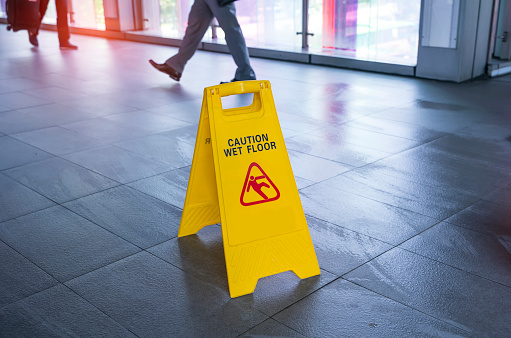Many injuries sustained during a slip and fall or trip and fall accident could be avoided with regular property upkeep and preventative action.
Slip and fall accidents occur when traction is reduced due to wet or oily surfaces, temporary spills, weather events, or a change in surface type. The following maintenance can create a safer environment for your family, guests, customers, and employees:

- Clean any spills immediately upon learning of them.
- If prompt cleaning is not possible, mark the area clearly with cautionary signage and redirect foot traffic.
- Proper lighting with easily accessible switches will help prevent accidents at night and in darkly lit areas of your home or business.
- Install doormats so guests and customers can clean their footwear before entering your home or business.
- Depending on the type of staircase flooring, consider installing no-slip treads that help prevent slips and provide depth perception for foot traffic.
- Create a maintenance plan for weather-related events that lead to slippery surfaces. Schedule inspections, log work completed, or contract the clean-up to another party with a written agreement in place. For commercial properties, be sure your weather maintenance plan covers both interior and exterior walkways and addresses heavily trafficked areas and outside walkways subject to be icy that require frequent salting.
Tripping losses happen when someone’s foot strikes an object causing them to lose their balance and fall. To minimize risks associated with tripping injuries, inspect your home or business, and take the following action:
- Remove any obstacles from passageways, staircases, and halls.
- Ensure that all area rugs and carpets are secured and lie flat. Consider non-slip underlayment and taping or tacks.
- Cover electrical wires, extension cables, and phone lines running across the floor.
- Ensure that cabinet drawers and doors are closed and secure.
- Inspect flooring, including stairways, for uneven surfaces and varying tread heights and mitigate if possible or post warning signage, providing caution to foot traffic. The same preventative steps apply to thresholds and single-step room separators.
- Clearly mark stairwells to ensure guests, customers, and employees are aware of an elevation change.
- Provide handrails in hallways and stairwells to provide stability.
- Inspect and repair any cracks or potholes in driveways, parking lots, and sidewalks.
While not all accidents can be avoided, taking preventative actions before an accident occurs can minimize the risk to you or your business and help you protect your piece of the world.